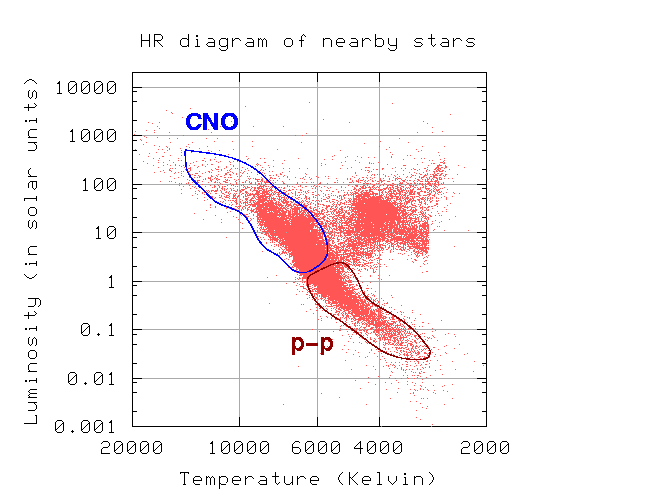
 Copyright © Michael Richmond.
This work is licensed under a Creative Commons License.
Copyright © Michael Richmond.
This work is licensed under a Creative Commons License.
Homework due in the next class
We look today at what happens to a star after it leaves the main sequence. As you will see, there is a big difference between stars of "low mass" -- roughly 2-5 times more massive than the Sun -- and those of "high mass" -- anything more than about 5 times the Sun's mass. I'll use these terms throughout the discussion. Please keep in mind that the boundary between the two groups is not known exactly, and may very well depend on other factors: the chemical composition or the presence of a close companion star, for example.
Stars on the main sequence fuse hydrogen to helium in their cores. The details of the reactions are somewhat different for stars of high and low mass:

You can read more about these reactions in
Both sets of hydrogen fusion reactions are very sensitive to temperature.

Because they are so sensitive to changes in temperature, both the p-p chain and the CNO cycle act as stellar thermostats. Changes in the rate of energy production can cause the layers of gas above the core to expand outwards, or shrink inwards. But at the same time, it is the gravitational pressure of these overlying layers of gas which produce the high temperatures required for the fusion reactions. The result is a delicate balance which tends to restore itself to equilibrium.
Looks grim ... but as the outer layers press the core inwards
You can show that if the central temperature rises a little for some reason, a similar series of actions will cause the core to expand a bit, dropping the temperature back towards its original value.
In short, the combination of the energy generated by fusion reactions pushing outwards and gravitational force pulling gas inwards leads to a stable equilibrium. As long as a star has hydrogen in its core to fuse, it will maintain a roughly constant central temperature; which means it will generate a roughly constant amount of energy; and that means it will shine with a roughly constant luminosity. Its position in the HR diagram (based on luminosity and photosphere temperature) won't change much at all during its long phase of hydrogen burning.
Using stellar models, one can predict the lifetime on the main sequence for stars of various masses; in other words, the length of time during which they can continue to fuse hydrogen into helium. The results may surprise you -- the most massive stars live the shortest lives:
initial mass (solar) lifetime (Myr)
-------------------------------------------
0.5 56000
1.0 12000
2.0 900
5.0 90
One can fit a very rough formula to this relationship:

You can use this formula to estimate the length of time that a star will remain on the main sequence.
Q: Roughly how long will a star of 10 solar masses remain on the main sequence?
Why do the most massive star die so soon? Because they use up their fuel much more rapidly than their low-mass cousins. Consider the specific example of a 10-solar-mass star and a 1-solar-mass star.
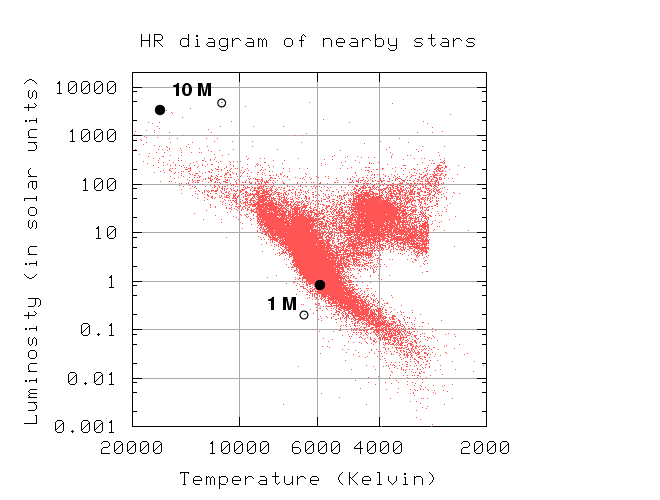
Q: How much more fuel does the high-mass star
have at the start of its life?
Q: What is the luminosity of the high-mass star?
What is the luminosity of the low-mass star?
Q: How much more energy does the high-mass star
generate each second?
Q: How long will the high-mass star last,
compared to the low-mass star?
A low-mass star like our Sun will move along a long, almost circular loop in the HR diagram as the nuclear reactions in its interior change. The basic steps are pretty simple:
We can take a quick look at the resulting motion on the HR diagram.
The moment at which the inner core begins to fuse helium to carbon is called the helium flash. After it occurs, the star settles down to a new phase of helium burning via the triple-alpha process. Once again, there is a nice thermostat to regulate the internal properties. The star moves onto a place in the HR diagram in the upper-right: the giant branch.
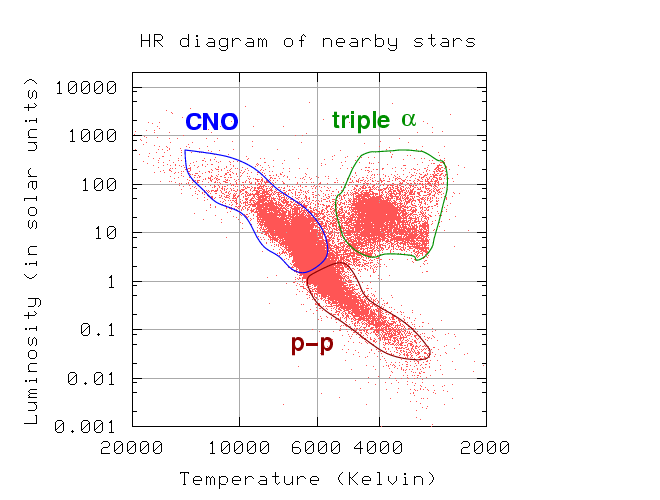
At this point, the star contains
This helium-burning phase of the star's life lasts quite a long time. Not as long as the hydrogen-burning main-sequence phase, for two reasons: first, not all the hydrogen has been turned into helium. Second, the helium-fusing reactions occur at a higher rate than the hydrogen-fusing reactions, due to the higher temperature and pressure of the innermost core. To a very rough approximation, a star fuses helium for about one-tenth the length of its main-sequence lifetime. The Sun, for example, will spend roughly one billion years as a red giant.
As the helium fuses into carbon, the carbon slowly accumulates at the center of the star. Collisions between carbon-12 and a helium nucleus can create the stable nucleus of oxygen-16, which increases with the carbon concentration. Eventually, the helium fusion is restricted to a shell outside a central core of inert carbon and oxygen.

And, once again, during a shell-burning phase, the star moves again up and to the right, along the asymptotic giant branch.
Will the temperatures ever rise high enough to ignite this core of carbon? No, not for stars which start out with less than about 4 solar masses of gas. Instead, the helium- and hydrogen-fusing shells gradually expand outwards. The process isn't always smooth -- the fusion reactions in both shells tend to run in fits and starts. If the hydrogen-fusing shell doesn't fuse quickly enough, for example, then the helium-fusing shell may run low on fuel, and shut down until more helium becomes available. These helium shell flashes can have strong effects on the outer envelope of the star ...
What happens to the outer envelope of a Sun-like star as the inner regions switch from fusing hydrogen to fusing helium? Two things:

When our Sun reaches the red giant stage, its outer layers will expand to swallow the planets Mercury, Venus, and maybe even Earth.

Because the outer layers of a red giant are so far from the star's center, the gravitational force on them is very weak. If the pressure of the radiation from the interior of the star should increase, it can easily shove the photosphere outwards a large distance; or, if the radiation pressure decreases slightly, the outer layers can fall inwards a long way before they reach equilibrium again. Stars in the red giant phase are very often somewhat unstable: their outer layers may pulse outwards and inwards over timescales of days to years.
If one particular pulse is especially strong, it may push a portion of the outer envelope outwards so hard that the gas flies off into space and never returns; in other words, it may give the gas a speed beyond the escape velocity of the star. This is one way that red giants may lose some of their mass. Even without sudden pulses, most red giants have very strong stellar winds: flows of atoms, ions and molecules from their outer atmosphere into space. A red giant's wind may carry as much as ten millionths of its mass away into space each year; the Sun's solar wind, by contrast, pushes about one hundred trillionth of its mass away each year.
The consequence of all this mass loss from red giants is the creation a huge shell of material speeding outwards into space around the star. Many stars lose their entire envelope, exposing their hot inner regions.
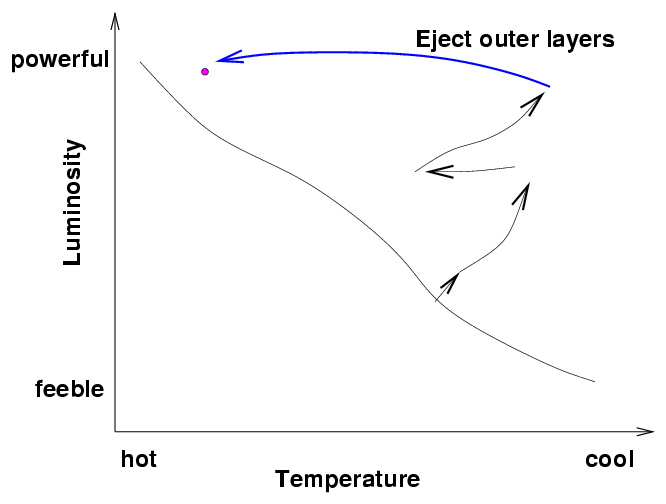
When the ultraviolet light from the exposed core strikes the atoms in the shell, it excites them to high energy states. As the atoms drop back down to lower levels, they emit light as beautiful planetary nebulae.
Some look like simple spherical shells of gas, such as M57, the Ring Nebula:
But others exhibit traces of complex structure, such as the Cat's-Eye Nebula:
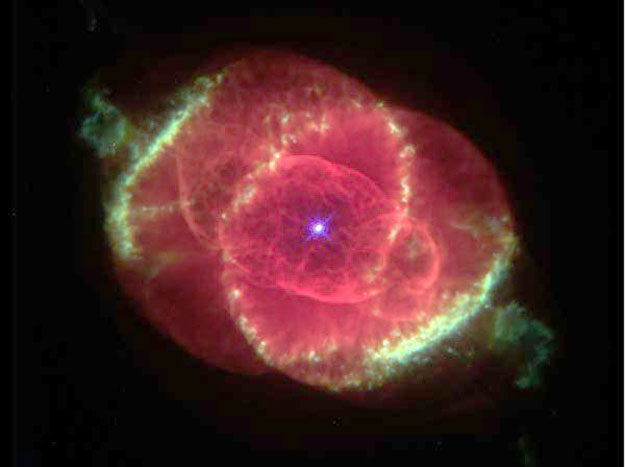
MyCn18,
or the Eskimo Nebula:
It appears that many planetary nebulae have a bipolar structure, in which material flows preferentially in opposite directions from the star:
It's not clear exactly what creates the structure within these glowing clouds of gas. It might be due the effects of stellar rotation on material flowing off the extended envelope. It might be due to magnetic fields. In some cases, it might derive from the orbit of a binary companion around the red giant. At the moment, we just don't understand planetary nebulae.
After it has exhausted the helium in its inner shell, a star has no way to generate more energy: there is no more hydrogen nor helium in its hot, dense central regions. When the pressure of radiation stops flowing outwards, the outer layers of the star (if any are left) fall back inwards. The star shrinks and shrinks upon itself, becoming denser and denser -- but not endlessly. When it reaches a size roughly equal to the Earth's, collisions between electrons in its core provide enough pressure to halt the collapse. The star settles down into a final state of equilibrium as a white dwarf: a very, very dense body consisting mostly of carbon and oxygen, with the mass of a star but the size of a planet.
White dwarfs start out very hot, due to the high temperatures of their inner regions. It takes that heat a long time to leak out to the surface and radiate away into space. Because they are so small, white dwarfs emit very little energy, despite their high temperatures. Being very hot, but very feeble, they fall in the lower-left corner of the HR diagram.
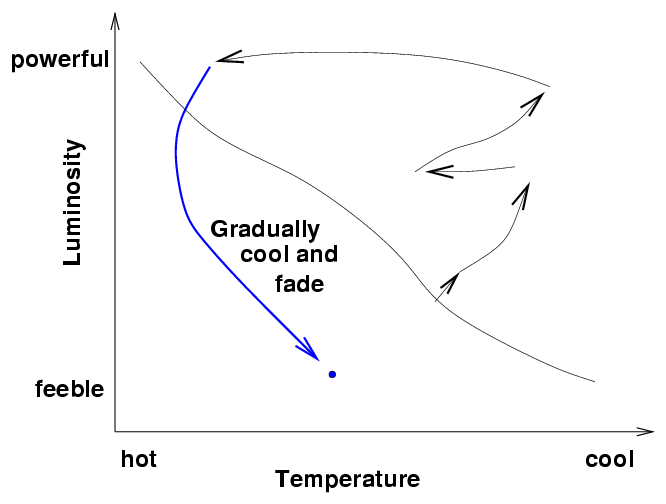
It takes billions of years for white dwarfs to cool, but eventually they do, moving ever down and to the right on the HR diagram. Their fate is to end up as cold, dense, lonely chunks of matter: black dwarfs. Some day, our Sun will join their ranks.
The crucial difference between the evolution of low-mass stars and high-mass stars is due to the higher temperatures and densities at the cores of high-mass stars. The higher temperatures allow high-mass stars to start fusing heavier and heavier elements together in their core. Instead of stopping at the fusion of helium into carbon, like low-mass stars, high-mass stars continue, fusing
Eventually, the interior of a high-mass star looks a bit like an onion:
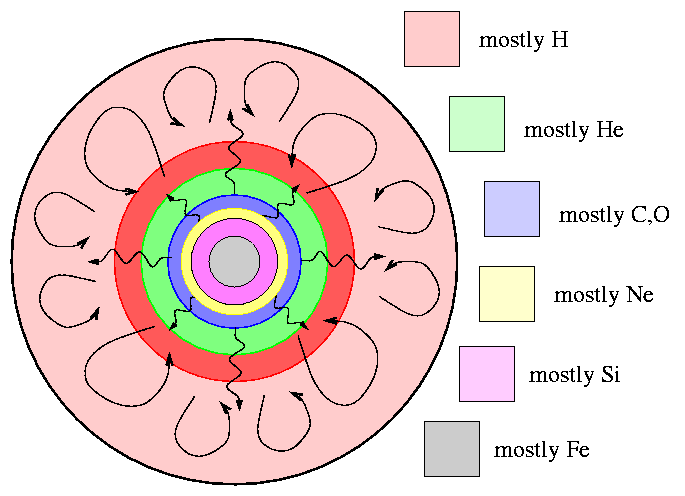
But the timescales for these stages become shorter and shorter, partly because there's a smaller initial amount of each fuel, and partly because the reactions take place at higher and higher temperatures and so go more and more quickly. The final stages go very quickly indeed:
fuel lifetime (for 20 solar-mass star) -------------------------------------------------- H 10,000,000 years He 1,000,000 years C 300 years Ne 0.5 years Si 0.01 years --------------------------------------------------
You can get a qualitative (but not quantitative) feel for the rapidity of the late stages by watching this animated GIF (which gives the final stages way, way too much time).
The evolution of high-mass stars on the HR diagram is quite different from that of low-mass stars: they always remain very luminous, but their outer layers can switch from hot to cool several times as the reactions in their interiors change.
When light elements -- such as hydrogen -- fuse together to form heavier elements -- such as helium -- the resulting nucleus has less mass than the original components. The "missing" mass turns into energy according to Einstein's equation

But it turns out that this process is most efficient for the very lightest elements. As one fuses heavier and heavier nuclei, the fractional payoff in energy becomes smaller and smaller. One way to show this is with the curve of binding energy .
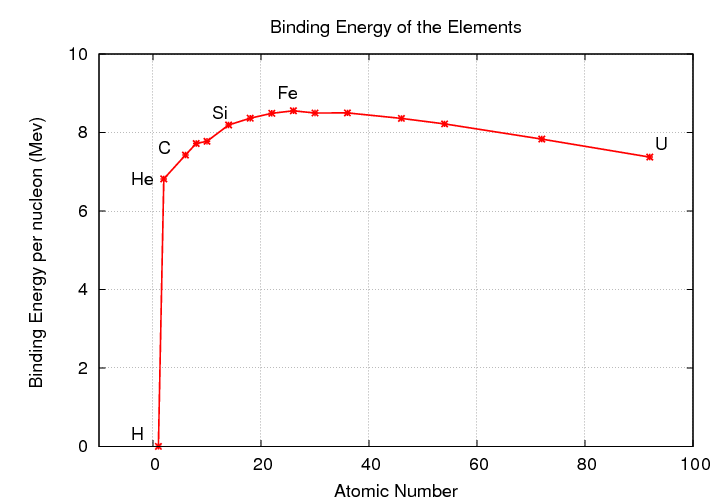
"Binding energy" measures the difference between the mass of a nucleus and the mass of the individual protons and neutrons which make it up. The larger the binding energy, the more mass disappears when you fuse elements together. If you fuse element A into element B, you get an amount of energy which depends on the difference
energy released = (binding energy of B) - (binding energy of A)So, for example,
Q: What happens when you fuse iron into heavier elements?
The answer is -- you LOSE energy! Instead of generating energy and increasing the temperature of a stellar core, fusion reactions involving iron will REMOVE energy, and drop the temperature.
So what happens when a massive star has built up a large core of iron? As the iron core is pressed in on itself, any reactions which take place don't release energy -- they "suck away" energy, decreasing the temperature of the core.
In a fraction of a second, the iron-rich core of the star collapses, from a sphere roughly the size of the Earth (radius 6000 km) to a ball of radius only 50 kilometers or so. As the core shrinks, the protons and electrons in it are crushed together to form neutrons. Neutrons are peculiar particles: they resist being pressed together closely (you can look up "neutron degeneracy pressure" sometime if you like). The core collapse halts when the pressure of the "neutron gas" reaches a critical level.
During the collapse, the reactions which turn protons and electrons into neutrons also release neutrinos. The core collapse of a massive star can produce a huge pulse of neutrinos, containing more energy in a single second than the Sun will radiate in a million years!
On 1987 February 23, at 07:36 UT, two neutrino detectors were in action: one in a salt mine near Cleveland, Ohio, and the other in Japan. Each detected a brief burst of neutrinos:

.... but no one noticed this immediately, because the bursts were small and didn't stand out greatly above the ordinary background noise.
Several hours later, astronomers in the southern hemisphere noticed something different about the Large Magellanic Cloud, a satellite of our Milky Way that looks sort of like a glowing, um, cloud, in the sky:
Here's a closeup:
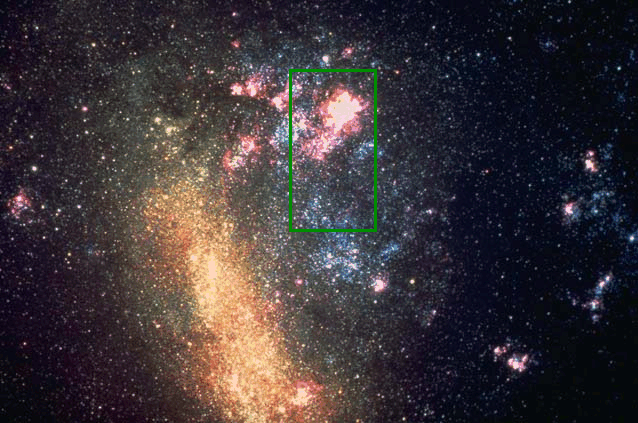
Image credit and copyright:
AURA
NOAO
NSF
The region inside the box is a big, bright HII region called the Tarantula Nebula. Normally, it looks something like the picture at left below ... But on this night, February 23, 1987, several of the astronomers noticed that it was different somehow (as shown at right):
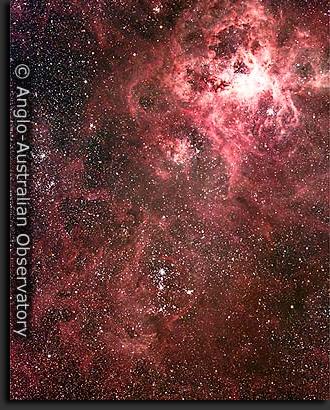
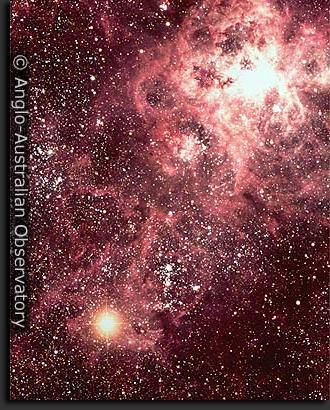
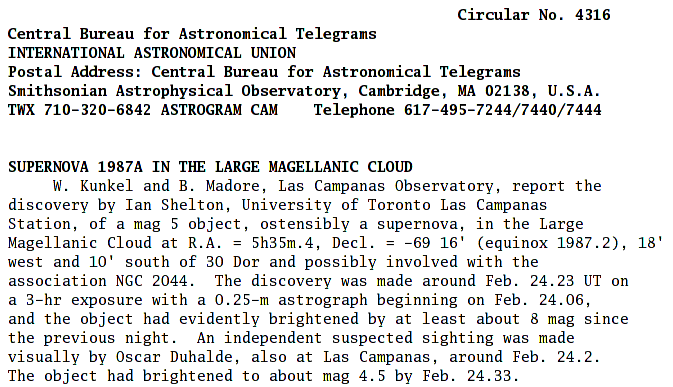
It was the visible light from the explosion finally reaching the Earth. It took several hours for the shock wave from the center of the star to move outwards through the star's atmosphere and reach the photosphere (the "surface"), giving rise at last to visible light.
We believe now that this event, called Supernova 1987A in the Large Magellanic Cloud, occurred when the core of a massive star collapsed suddenly. Over the next minute or so, the inner layers of the star fell onto the super-dense core. The collision of these layers with the core created a shock wave which shoots back outwards at thousands of kilometers per second. The shock wave ripped through the outer layers of the star, heating them up to millions of degrees and shoving them outwards violently. Several hours after the core collapsed, the shock wave broke the surface; the outer layers suddenly exploded and radiated X-rays, ultraviolet and visible light like crazy.
Every year, astronomers notice several hundred supernovae in galaxies all over the sky. Most of them are so faint that one cannot see them without a large telescope and a sensitive camera. The ones which are near enough to appear visible to the naked eye occur about once every couple of centuries.
For a few weeks, the supernova can outshine an entire galaxy and its hundreds of billions of stars. However, as the expanding shell of gas radiates away its energy, it begins to cool. The supernova gradually fades, dimming to about 1 percent of its peak intensity after three or four months.
As the years pass, the shell of ejected gas becomes cooler and cooler, dimmer and dimmer -- but also larger and larger. In 1993, a supernova exploded in the nearby galaxy M81:
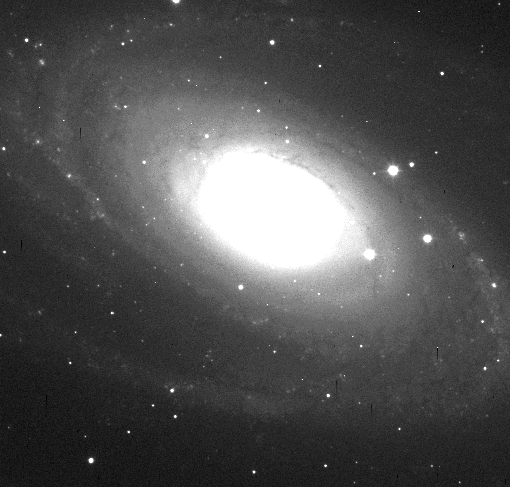
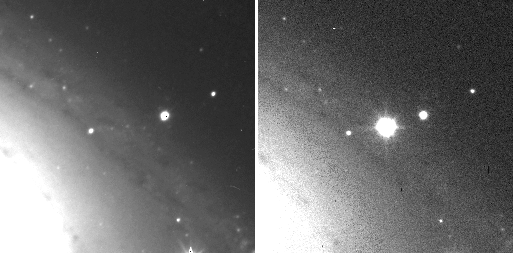
Radio astronomers were able to watch the shell of gas expand with time after it was blown off the star:
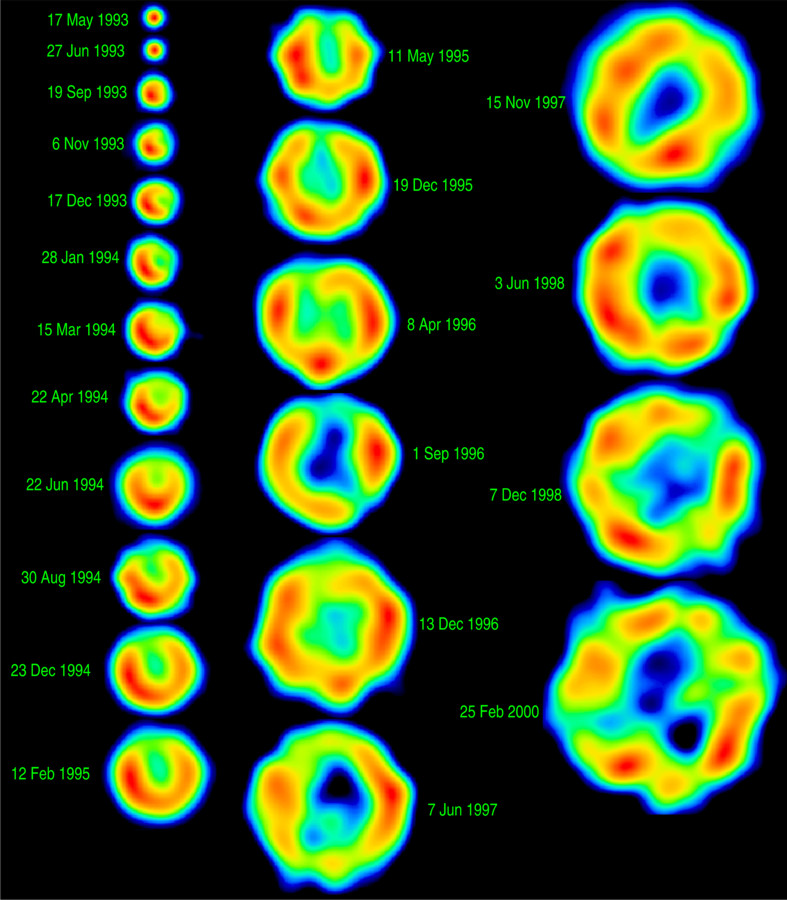
Image courtesy of NRAO/AUI and N. Bartel, M. Bietenholz, M. Rupen, et al.
In our own galaxy, we can look at the remnants of a supernova which exploded in the year 1054: the Crab Nebula. Pictures taken in 1973 and 2000 reveal the continuing expansion of the gas.
After tens of thousands of years, the ejected material starts to merge with the general interstellar medium.
It will enrich other clouds with the heavy elements which were once deep inside the stellar interior, elements such as carbon, oxygen, potassium, calcium and iron. The very atoms which make up your body were once blown out into space in a supernova.
 Copyright © Michael Richmond.
This work is licensed under a Creative Commons License.
Copyright © Michael Richmond.
This work is licensed under a Creative Commons License.